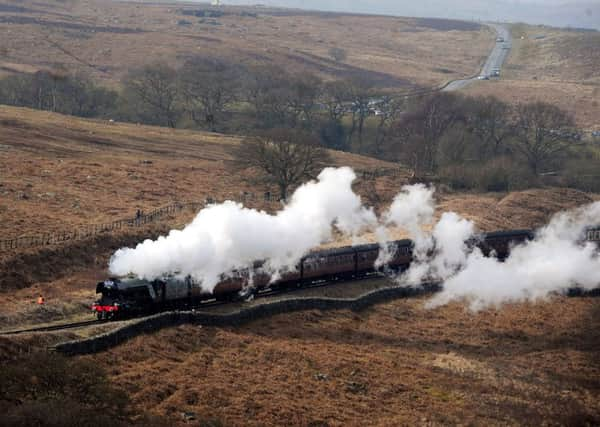YP Letters: The Flying Scotsman and Sir Nigel Gresley's quest for perfection


THE A1 class locomotives, such as Flying Scotsman, when built in 1922, were inferior engines for their size as shown by the trials against a much smaller G. W. R. ‘Castle’ class engine (The Yorkshire Post, March 11).
However, the basic design was sound and Sir Nigel Gresley spent the next 10 years improving it and these improvements were incorporated into existing engines when practical and then designated the A3 class.
Advertisement
Hide AdAdvertisement
Hide AdGresley then took the design and improved it again producing the streamlined A4 class. This was superb, but he still looked for improvements and the last five were built with double chimneys. This was a direct result of fitting one to A3 Humourist. The first built of these, Mallard, was so good it was used on the trials resulting in the world steam speed record.
At this point the war and then Sir Nigel Gresley’s untimely death intervened and it was not until British Rail days that this improvement was incorporated in the rest of his A3 and A4 classes. Rather than turning in his grave as Canon Storey says, Sir Nigel would be saying “that was my intention”.
From: Hugh Rogers, Ashby.
CANON Storey (The Yorkshire Post, March 11) clearly knows his onions when it comes to locomotives (were the changes of which he complains the fault of the dastardly Europeans, I wonder?) but he is wrong about the Spitfire, which used a number of different engines and had umpteen design changes since its first appearance in the 1930s. One only has to consider, as an example, changes in cockpit shape from the original cylindrical to a bulged version which I believe came out in 1940. Altogether, there were 24 “marks” as combat experience fed through to the basic design (which never really changed, unless you count the naval version, the Seafire, which had double folding wings).
The only one which I was faintly unhappy with was the conversion to a two-seater for training and joy-rider purposes which I feel took too much away from the original conception of this magnificent aircraft as a single-seater fighter.
From: David Priestley, Leeds.
Advertisement
Hide AdAdvertisement
Hide AdWHAT is the point of spending £8m-plus on this new station at Apperley Bridge when you can only catch a train either early morning before 9am or evening time after 6pm-7pm?
It is also pointless having the shuttle bus running all day every hour on the hour to the station to meet up with non-existing trains. Also the times of the bus do not tie up with the trains.
This is a big white elephant, just like the super cycleway is going to be between Bradford and Leeds. What a waste of money.
Airport at mercy of road
From: Geoff Allen, Pudsey.
RE recent letters on Robin Hood Airport. I have made many trips to Doncaster and several to the airport and I would suggest anyone contemplating travelling from the Leeds area should allow plenty of time over and above the hour it takes to get there when the M62 and A1 are running clear.
Advertisement
Hide AdAdvertisement
Hide AdThese roads, in particular in winter, can be notorious for accident and hold-ups. Leeds Bradford Airport may not be perfect, especially the drop off charges, but I would suggest that serious hold-ups are unusual.
From: Peter Langtry-Langtons, Addingham.
ON communications to Leeds Bradford Airport, there must be loads of tunnelling equipment going spare, after the London transport bonanza (to which us mugs in Yorkshire have had to contribute).
It should be shifted up here, post haste (before it goes rusty) to dig a tunnel rising from Guiseley Leeds-Bradford junction to underneath the airport, falling gently thereafter, to the west end of the Bramhope tunnel.
All linking Bradford, Leeds, Harrogate and York, by normal rail to the air terminal.
Advertisement
Hide AdAdvertisement
Hide AdObviously a station at the airport would be deep underground. More an opportunity than a problem.
City region is no use to us
From: Coun Peter Horton, Independent, Ripon South.
YOUR front page report (The Yorkshire Post, March 11) quotes Bradford Council’s leader as saying that local Conservative MPs were blocking a West Yorkshire devolution deal for narrow political reasons.
It is regrettable that the five West Yorkshire councils are aiming to form the Leeds City Region (LCR) and to pull in three district councils from North Yorkshire, namely Craven, Harrogate and Selby.
This proposal, of course, decimates North Yorkshire and just leaves a rump of mainly rural areas, and it certainly does nothing for places like Ripon, Masham and Boroughbridge where there is little or no affinity with Leeds, but would be dragged into the LCR arrangement as part of the existing Harrogate Borough Council territory.
Advertisement
Hide AdAdvertisement
Hide AdDevolution progresses apace in Wales and Scotland, so surely it is better for the north of England to join forces in a massive counter-weight to the Scottish economy.
Even if we cannot bring Lancashire, Cumbria and Northumberland into the fold, a Greater Yorkshire would be an impressive economic unit as opposed to minor amalgamations such as the LCR.
I fear that the narrow political reasons lie not with the region’s MPs but with the West Yorkshire Labour-run councils.